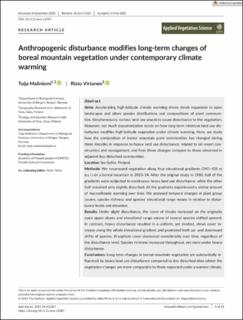| dc.description.abstract | Aims
Accelerating high-latitude climate warming drives shrub expansion in open landscapes and alters species distributions and compositions of plant communities. Simultaneously, various land use practices cause disturbance to the vegetation. However, not much documentation exists on how long-term intensive land use disturbance modifies high-latitude vegetation under climate warming. Here, we study how the composition of boreal mountain plant communities has changed during three decades in response to heavy land use disturbance, related to ski resort construction and management, and how these changes compare to those observed in adjacent less disturbed communities.
Location
Iso-Syöte, Finland.
Methods
We resurveyed vegetation along four elevational gradients (240–426 m a.s.l.) on a boreal mountain in 2013–14. After the original study in 1980, half of the gradients were subjected to continuous heavy land use disturbance, while the other half remained only slightly disturbed. All the gradients experienced a similar amount of macroclimatic warming over time. We analysed temporal changes in plant group covers, species richness and species’ elevational range means in relation to disturbance levels and elevation.
Results
Under slight disturbance, the cover of shrubs increased on the originally open upper slopes and elevational range means of several species shifted upward. In contrast, heavy disturbance resulted in a uniform, yet modest, shrub cover increase along the whole elevational gradient and promoted both up- and downward shifts of species. Bryophyte cover decreased considerably over time, regardless of the disturbance level. Species richness increased throughout, yet more under heavy disturbance.
Conclusions
Long-term changes in boreal mountain vegetation are substantially influenced by heavy land use disturbance compared to less disturbed sites where the vegetation changes are more comparable to those expected under a warmer climate. Therefore, along with the climatic effects, land use effects on vegetation are important to consider in management actions and in projections of future vegetation. | en_US |

